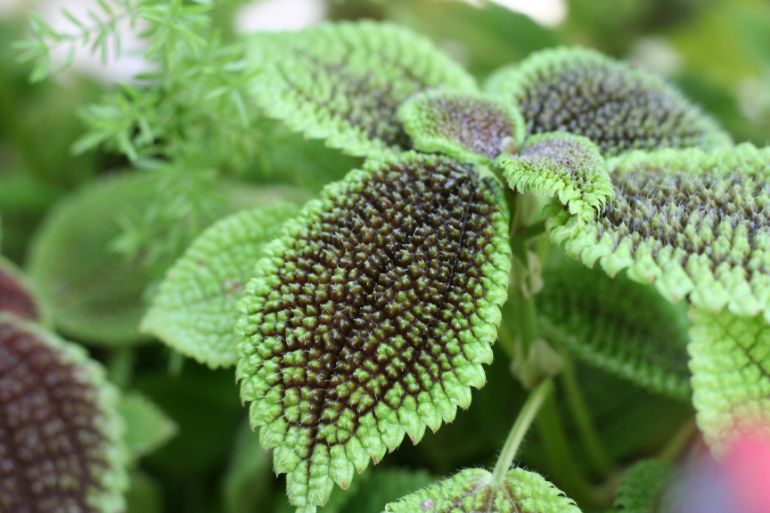Pilea involucrata is popular for its colorful, highly textured foliage and easy-going ways. It’s an excellent beginner’s houseplant, but it has a few quirks. In this article, we’ll explain everything you need to know about Pilea involucrata care, to help you keep your plant looking great.
Pilea Involucrata prefers bright, indirect light and temperatures of 65-75ºF (18-24ºC). Plant in well-draining potting mix and water once the top inch of soil dries out. Provide humidity of >50% and fertilize twice yearly. Pinch back to maintain compact growth and avoid repotting unless rootbound.
Pilea Involucrata Overview
This cute little Pilea is from the Nettle family (Urticaceae), but its fuzzy hairs happily lack the sting of the group’s less-friendly members. There are over 600 species in the Pilea genus including both trailing and upright, bushy types – the versatile Pilea involucrata can be grown in either form.
This is definitely a foliage plant: its small flowers are easy to overlook. The deeply corrugated, attractively patterned, multicolored leaves are oval with serrated edges and darker longitudinal veins. Their exotic leaf pallet is a mix of bronze and burgundy hues contrasting with wide green outer margins … the undersides have a red to purplish color.
Native to South and Central America, Pilea involucrata is intolerant of frost and wet soil but quite adaptable otherwise. It’s a moderately fast grower that may reach a foot high and wide but usually stays smaller. The leaves are from one to three inches long.
This undemanding species is commonly called the Friendship Plant because it’s so easy to propagate and share with fellow gardeners. It’s also called a ‘Moon Valley’ Pilea for its textured, moonlike surface.
By either name, the Pilea Involucrata is widely available and creates a striking contrast among the green foliage of typical tropical plants. It can be either an accent or a standalone showpiece and kept as a bushy desktop plant or in a hanging basket. It’s a great terrarium species, too.
Pilea Involucrata Care Summary
| Scientific Name | Pilea involucrata |
| Common Name | Friendship Plant, Moon Valley Pilea |
| Origin | South and Central America |
| Light Requirements | Pilea involucrata likes bright, indirect light but can handle a range of conditions; just be sure to shield the tender foliage from intense, direct sun and let them acclimate gradually. |
| Watering | Wait until the top inch of soil dries out before watering. Give the mix a thorough soaking and let it drain completely … don’t rewater until the top inch of soil dries out again. |
| Soil | Use a rich and very well-draining medium. 2/3 peat moss or coco coir is a good base to mix with 1/3 perlite or other inorganic amendments to increase aeration. |
| Temperature | A range between 65ºF (18ºC) to 75ºF (24ºC) is ideal, with perhaps an evening drop of a few degrees. |
| Fertilizer | Fertilize with a balanced blend diluted to half- or even quarter-strength. Apply in spring and again in mid-summer. |
| Humidity | Pilea involucrata is native to tropical climates and does best with humidity of >50% |
| Flowering | Produces small and undistinguished cream- or pink-colored blossoms. They look like frothy foam and make a pleasant accent against the foliage. |
| Pruning | Pinch or trim back stems as needed to maintain compact growth. |
| Propagation | Pilea involucrata is very easy to propagate from stem cuttings or by planting the baby offsets that grow along the stems of mature plants. |
| Re-Potting | Rarely needs to be repotted. Wait until showing signs of becoming rootbound and increase the pot size by a maximum of 1-2 inches. |
| Diseases and Pests | Fairly pest and disease resistant. Sometimes affected by aphids, mealybugs, and spider mites. Rarely impacted by diseases other than root rot. |
| Toxicity | Pilea involucrata is non-toxic to humans and animals. |
| Where To Buy | Buy Pilea involucrata online at Etsy (I buy most of my houseplants from Etsy) |
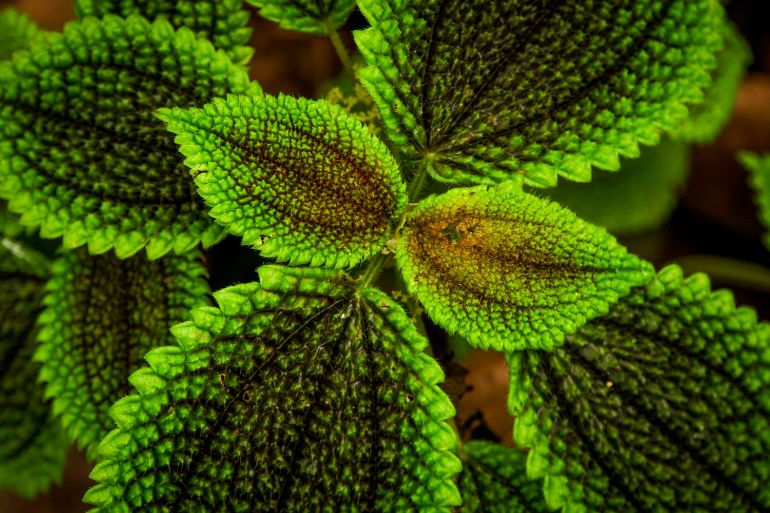
Pilea Involucrata Light Requirements
This versatile Pilea likes bright, indirect light but can handle a range of conditions; just be sure to shield the tender foliage from intense, direct sun. They can thrive in mild or dappled sunlight, but let them acclimate gradually.
The Pilea involucrata is sometimes sold as a low-light choice – and it can survive in fairly dim situations – but there is a tradeoff. The foliage darkens and becomes less colorful if the light is low, and the stems stretch and become leggy.
An east-facing windowsill is usually ideal, but the plant does fine in a brighter exposures with suitable protection. Sheer curtains can do the job, but simply pulling the container back a couple of feet will work, too.
This plant also does well in artificial light, making it easy to add a grow light to a dark corner or terrarium to increase their illumination.
How To Water Pilea Involucrata
Happily, watering isn’t a hassle with this plant. It doesn’t like to endure a parched existence, of course, but if you avoid overwatering or letting the soil go bone dry there shouldn’t be issues.
Wait until the top inch of soil dries out before watering. Give the mix a thorough soaking and let it drain completely … don’t rewater until the top inch of soil dries out again. Monitor the medium and only water when needed instead of using a schedule.
Overwatering is the most common Pilea involucrata care problem, and your plant will perish in persistently wet soil. Cut back on watering in the cool months when the plant is not growing.
Of course, extreme underwatering is harmful, too, but the plant sends up a flare by wilting slightly when the soil is too dry. It won’t collapse dramatically before turning crisp, but it doesn’t suffer invisibly.
Rich, Open Soil
The best soil for the Pilea involucrata is a rich and very well-draining medium. It’s much easier to water properly if the soil is open and doesn’t become a bog.
Peat moss or coco coir is a good base to mix with perlite or other inorganic amendments to increase aeration. African violet potting soil is another good base. Adding some organic elements like compost or leaf mold are good for fertility, but don’t overdo it.
High Humidity Preferred
The Pilea involucrata is native to tropical climates and naturally appreciates high humidity, but it’s a pretty good sport about it. If you offer average levels of at least 50%, the plant can adjust.
Most homes tend to be arid and become more so whenever heating or air conditioning are being used, so you may find that certain seasons are particularly humidity-challenged. Symptoms of a plant struggling with low humidity include browning leaf edges and lackluster growth.
Grouping tropical plants is a good way to modestly increase humidity. Pebble-filled water trays placed around or underneath the plant can also help. Either method – or both – can bump up moisture levels to a humidity range the plant is comfortable with. I cover some other ways to increase humidity for your houseplants here.
Warm Temperatures
One reason why Pilea involucrata care is so easy is that we share temperature preferences: if you’re warm and comfortable, this plant probably is too. A range between 65ºF (18ºC) to 75ºF (24ºC) is ideal, with perhaps an evening drop of a few degrees.
Important points:
- The plant will tolerate warmer temperatures better than cold ones: it starts to suffer as the thermometer drops below 50ºF (10ºC). Keep it out of frosty windows and away from heaters!
- The plant survives outdoors year-round in USDA Zones 11 and 12.
- A bitter frost will kill it off. Specimens may survive a light frost but the leaves will be damaged or destroyed.
- Drafts can harm the plant, whether the air is hot or cold.
Light Fertilization
This small species isn’t a heavy feeder; in fact, overdoing it with fertilizer can start trouble. Especially if the soil is rich in organic material, the plant can do well with very little. My recommendation is to fertilize in spring and again in mid-summer with a balanced blend diluted to half- or even quarter-strength.
Some growers dilute the fertilizer even more and apply monthly during the warm season to better fit their feeding regimen, but this isn’t really necessary. Don’t fertilize during the fall and winter months. If you’re not 100% confident about how or when to fertilize your houseplants, this article explains all you need to know.
Pilea Involucrata Flowers
Though your Pilea involucrata may bloom occasionally, it’s nothing to get excited about. The cream- or pink-colored blossoms are small and undistinguished. They look like frothy foam and make a pleasant accent against the foliage.
The species isn’t a punctual bloomer and might never produce flowers indoors. You may cut them off if you wish.
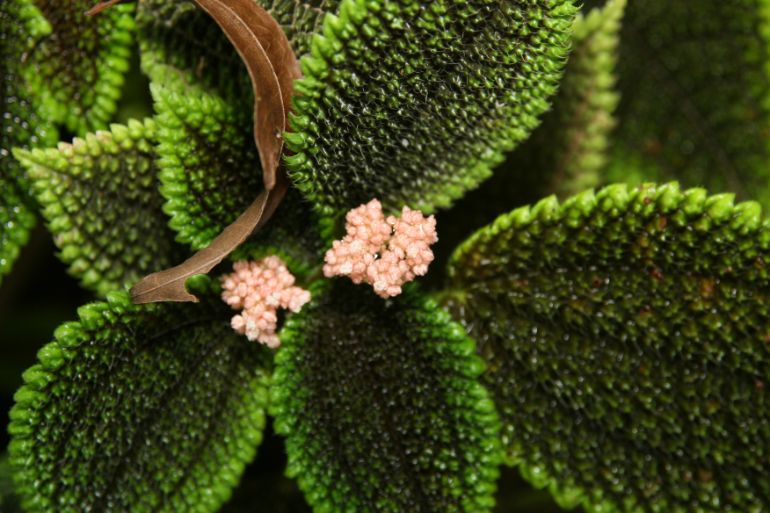
Infrequent Repotting
Repotting shouldn’t be a frequent part of your Pilea involucrata’s regimen. Between new soil and having its roots disturbed and torn, repotting is a bit traumatic to the plant.
The good news is that this species has a small root system and doesn’t make a fuss about being slightly rootbound. Waiting a couple of years is often appropriate. When you do repot, do it in the spring so the plant can recover during the warm growing season.
You can tell the plant is ready if it’s grown significantly and/or roots are extruding from the drainage and topsoil. The need to water more frequently than usual is another sign.
Here are some repotting tips:
- Minimize damage to the roots – even gentle shaking and firm tamping damages the thin, delicate root hairs.
- Only increase the container’s size by one inch of diameter when you repot.
- Don’t forget the plant will need some downtime afterwards. Trying to snap a languishing plant out of its reverie by fertilizing or moving it will only delay recovery.
How To Prune Pilea Involucrata
It’s important to prune Pilea involucrata to keep it looking good. The stems are brittle and easy to pinch off.
- A Pilea involucrata tends toward legginess as it ages – the process is accelerated in low light that causes the plant to stretch.
- The stems grow out in all directions, too, and pinching them back will keep the plant compact.
- It’s also smart to remove dead or dying foliage and stems to manicure the plant and eliminate points of infection or infestation.
- Pruning will be needed if your Pilea is overgrowing their setting, which isn’t uncommon in a terrarium landscape.
Trimmed stems can regenerate with more compact growth if their light is sufficient. Pruning may encourage some branching from the trimmed point, too.
Pilea Involucrata Propagation
The Pilea Involucrata is very easy to propagate from stem cuttings. It’s almost as easy as the other common way of reproduction: planting the baby offsets that grow along the stems of mature plants. (The plant can’t make it easier!)
If your specimen isn’t producing offsets yet, or you’d like to increase production, rooting stem cuttings is simple and straightforward:
- The best time to take cuttings is in the spring. Each stem should be about three inches long and have two or three leaves.
- Plant the cuttings in a moist, peat-based medium (peat-free alternatives work well too). Optionally, you can dip the cut ends into rooting hormone, but this isn’t necessary. Gently tamp the soil around the stem but don’t press too firmly – you want the soil to breathe.
- Keep the cuttings warm, about 75º (24ºC). It’s a good idea to cover the plantings with clear plastic to increase humidity if the ambient air is dry.
- The stems should have sprouted roots in three to six weeks. Transplant into individual containers with suitable soil and begin normal care.
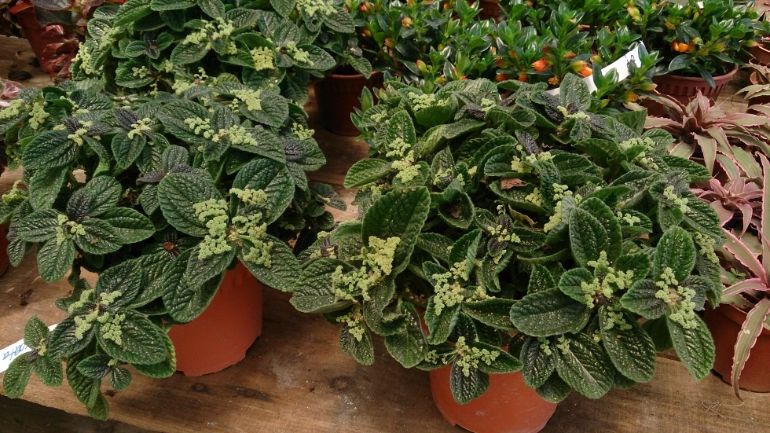
Pilea Involucrata Care Tips
- Pilea involucrata grows best in small pots. They may put energy in growing roots rather than leaves if their small root systems are lost in a large volume of soil.
- Pilea involucrata will grow lopsided as it reaches towards the light. Rotate your plant regularly to keep it balanced. Giving their container a quarter-turn clockwise each time you water is an excellent method.
- Don’t repot when you first receive a plant; let it acclimate the new conditions. Even if you intend to move the plant out of its nursery container, wait a few weeks to avoid adding to its stress.
- If your new Pilea was shipped, it is likely quite stressed and will need longer adjustment time. Be patient.
- Seasonal changes can greatly alter the brightness. Consider moving your plant to adjust lighting through the year, or add artificial light to supplement the source through a dark winter.
- The fragile stems snap easily and need careful handling. If you do accidentally break off a piece, consider propagating it … just stick it in moist soil!
Pro Tip: The trick to growing a fuller and bushier pot is to replant your stem cuttings back into the container’s soil. Try to keep the mix slightly moist (but not sodden) until the roots grow.
Is Pilea Involucrata Toxic?
More good news about your Friendship Pilea: it’s not toxic to pets or children! Or to you, either, if you’re inclined to partake.
Pilea Involucrata Varieties
You may occasionally see plants for sale that are labeled as cultivars of Pilea involucrata. However, from my research, these are normally other Pilea species that have been mislabelled.
Pilea involucrata displays considerable variation in appearance, and two specimens can look more like different cultivars than each other. Individualism is part of the plant’s charm.
That said, there is a semi-recognized variation called the Pilea mollis that appears to be a cultivar with a taller and more upright profile. In this characterization, the original species grows to six or eight inches high while the Mollis reaches up to a foot in height.
Incidentally, the common name “Moon Valley” is applied to both varieties. This is not to confuse collectors, but because it aptly describes the fissured surface of their leaves.
Pests And Diseases
Another wonderful thing about Pilea involucrata care is that you won’t be overly troubled by pests. It isn’t exactly bug-PROOF, but it isn’t a magnet.
All the usual invaders may occasionally show up: mealybugs, spider mites, and aphids can hop aboard from other plants. Catching them early is key.
Check your plant for pests each time you water. Look under leaves and into crevices. Some are tiny: a magnifying glass is helpful. If you see unwelcome wildlife, identify the culprits and begin treatment immediately – the plant might brush off a pest or two, but if an infestation develops it can suffer.
Dab individual insects with isopropyl (rubbing) alcohol. If there’s a colony to contend with, gentle but effective treatments include light horticultural oils and insecticidal soap. Cover all the plant’s parts to insure contact with the invaders. Repeat until the infestation is gone.
The Pilea involucrata isn’t prone to disease, either. Other than root or stem rot from overwatering, their main complaint is Leaf Spot.
If your plant does develop an infection, isolate the plant and remove affected leaves; discard them safely to avoid further contamination. Avoid getting water on the leaves and consider upping the light.
Common Pilea Involucrata Care Problems
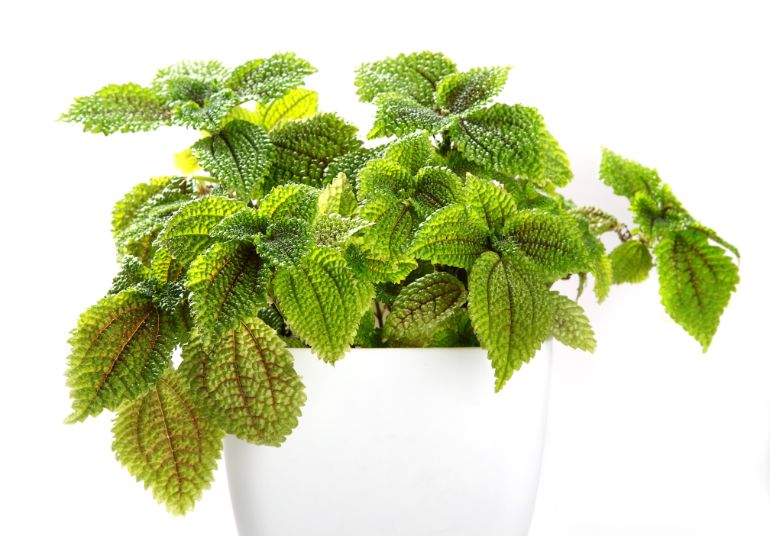
How Can I Fix My Leggy Pilea Involucrata?
Unfortunately, specimens become leggy, lose their lower leaves, and generally become bedraggled with age.
The usual solution is simply to start a new plant from cuttings or offsets. The species is so easy to propagate that growing these plantlets alongside their parent can create a perpetually youthful pot.
How Can I Make My Pilea Involucrata Grow Faster?
Though it isn’t the very fastest grower, providing good Pilea involucrata care is the best way to help your plant grow as quickly as possible:
- Keep the plant on the warm side of its preferred range.
- Give it bright light! The plant lives naturally in dappled sunlight and tolerates mild direct morning or late sun. Just be sure to let it acclimate to brighter conditions, and monitor it for scorching.
- Increase humidity. Pilea involucrata can survive in lower humidity, but it will do even better with higher levels. A healthier plant grows faster!
- Fertilize … but exercise caution. Dilute a balanced liquid formula and apply as often as once a month during the warm season. More is not better: too much fertilizer can toxify the soil. Stop fertilizing in the cooler months altogether.
Help! My Pilea Involucrata Has Curling Leaves
Providing good Pilea involucrata care is the best general preventative – but if you’re seeing curled leaves, it’s important to rule out two possibilities:
Overwatering – Check the soil. If the mix is soggy, unpot the plant and inspect the roots: they should be pale, firm, and sweet-smelling. If the plant is curling from root rot, you’ll see brown or black mushy roots that have a foul odor.
If rot has set in, it’s often best to take cuttings and start over … you can try to save an infected plant if it’s not too far gone, but success varies.
Pest Infestation – If you’ve missed some early visitors and the pests have established a colony, curled leaves could be the result. Unroll and check the leaves; give the plant a thorough inspection. Treat any found pests appropriately.
Why Is My Pilea Involucrata Drooping?
The most common cause of a drooping Pilea involucrata is underwatering, but a plant with root rot can also droop in a similar way. Check the moisture status of the plant, and drainage of the pot and soil to distinguish between the two. Many causes of stress can also result in a Pilea involucrata drooping, including transplant shock, temperature stress, and severe overfertilizing.
Why Does My Pilea Involucrata Have Brown Leaves?
Brown leaves are often due to underwatering, but excess direct sunlight, or very low humidity will also cause brown leaves, particularly at the tips and edges of the leaves. It is normal for a few older leaves to turn brown and drop over time, but it the problem is affecting many leaves, or younger foliage, it is almost always the result of a problem with the care conditions.
How Big Does Pilea Involucrata Get?
Pilea involucrata rarely grows more than 12 inches (30.5 cm) high. Most plants remain between 6-12 inches (15-30.5cm) in height and spread slowly over time.
Last Word
Hopefully, these Pilea involucrata care tips will help keep your plant thriving or may help you spot a few things to make your plant even happier. If you’d like to learn more about growing beautiful houseplants, check out some more of my articles listed below. Alternatively, if you would like a step-by-step guide to grow your green thumb, check out my book, “Houseplants Made Easy“.
- Light Requirements For Houseplants
- Complete Guide To Aluminum Plant Care (Pilea cadierei)
- How To Propagate Pilea peperomioides
- How To Choose and Make Houseplant Soil
- Best Plants For Terrariums
Published on 3rd May 2021

